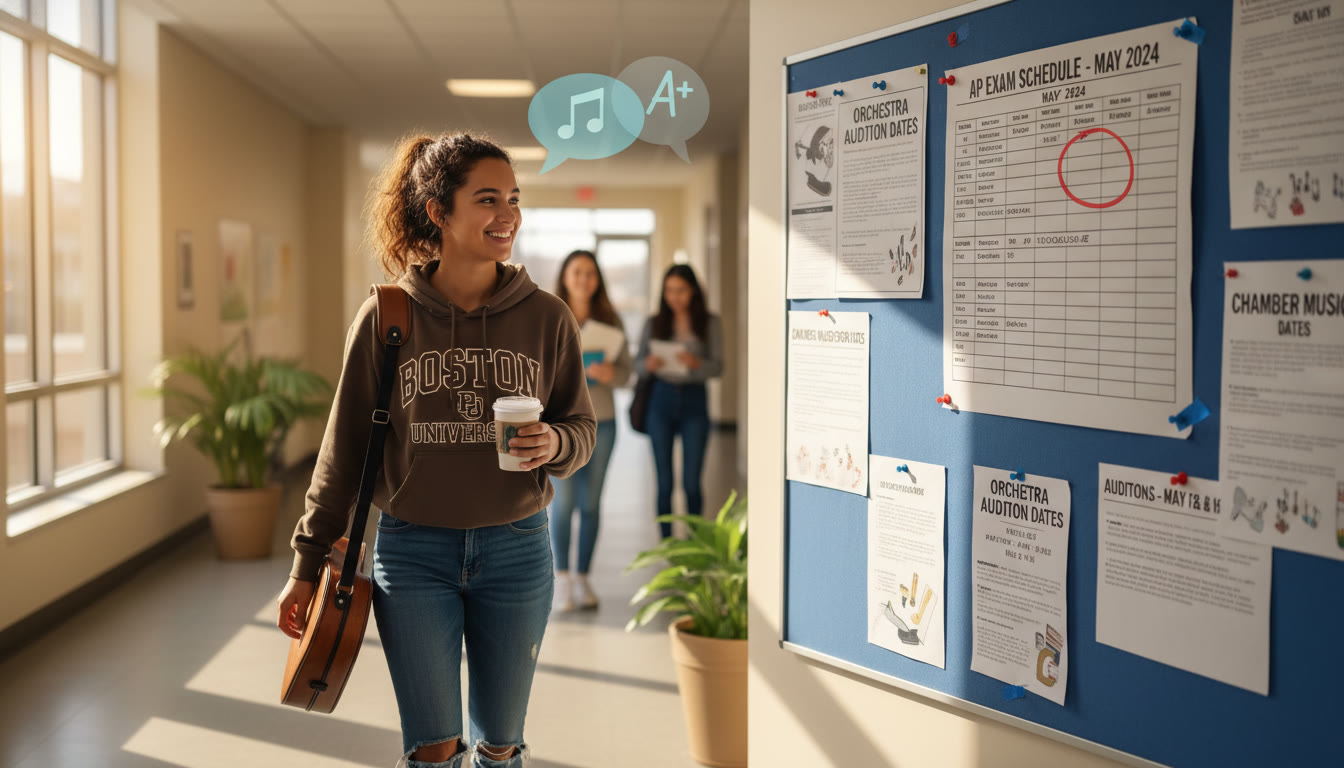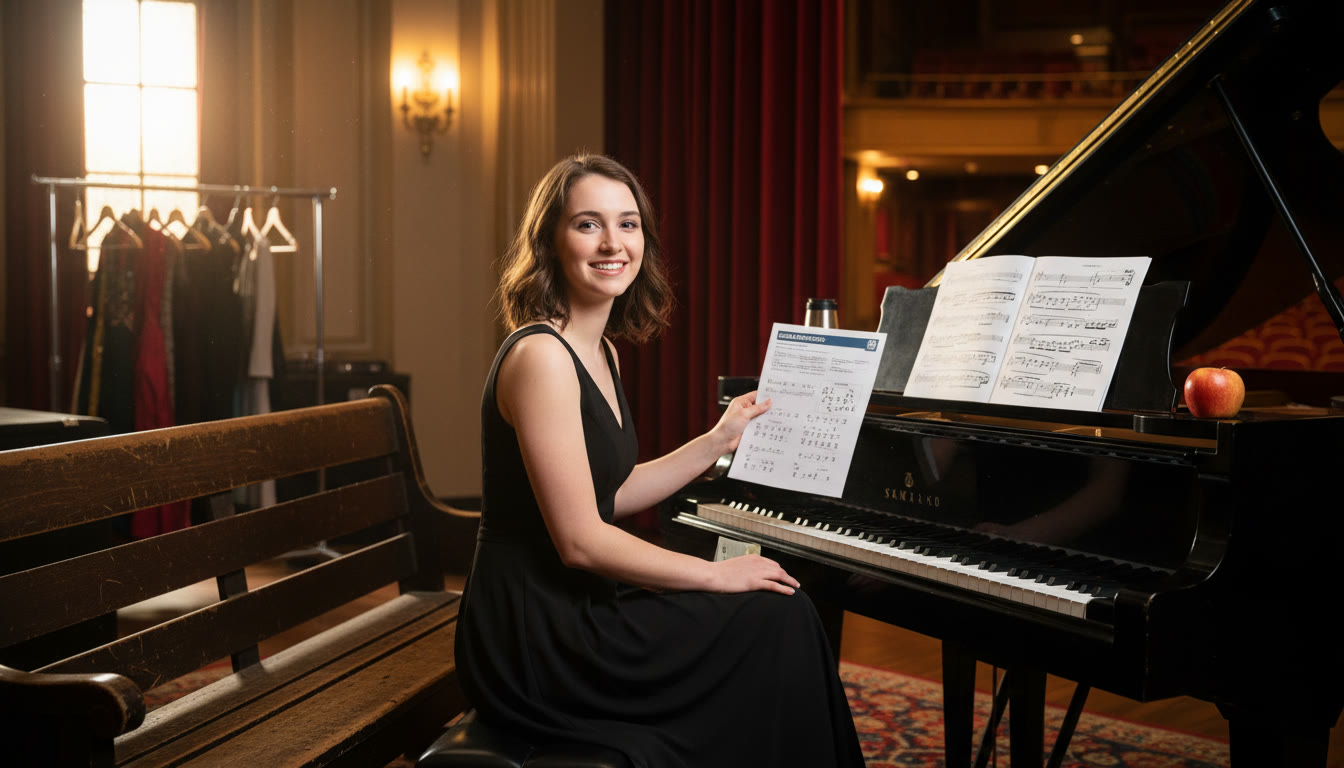Introduction: The Two-Test World Performing Arts Students Live In
If you re a high school musician, actor, dancer, or parent of one, you already know what schedule conflict feels like: dress rehearsal the night before a juried audition, a regional orchestra rehearsal stacked on the one Saturday you could have taken a practice SAT, or an AP exam in early May that collides with a state-level competition. Choosing whether to prioritize AP exams or the Digital SAT (and when to take each) is not purely academic it s deeply practical and personal.
In this blog we ll walk through the realities performers face when planning APs and the SAT, compare timelines, unpack how colleges view each test, and give concrete scheduling strategies that respect both your artistic commitments and academic goals. You ll also find real-world examples, a comparison table, and natural ways to get targeted help like Sparkl s personalized tutoring to make the process manageable, not overwhelming.

What Are You Comparing? Quick Definitions
Before diving into calendars, here s a short refresher so everyone is on the same page:
- AP Exams: Subject-specific Advanced Placement exams offered by the College Board. Many AP exams are in early to mid May (with some arts portfolios or digital submissions having different windows). AP Music Theory and AP Art and Design have components that can require performance, recording, or portfolio work. Schools usually administer AP exams at the school site and deadlines to register/order are set each fall or winter.
- Digital SAT: The SAT moved to a digital format and is generally offered on set national dates throughout the year plus SAT School Day options where schools host the test during a weekday. Many students take the SAT in the spring or fall of junior year and sometimes again in senior year if needed.
Scheduling Realities: Timing and Typical Conflicts
Performing arts students juggle recurring cycles: rehearsals, recitals, auditions, competitions, and sometimes touring. Let s unpack how AP exam timing and SAT dates typically interact with those cycles.
AP Exam Timing and What Makes It Unique for Performers
AP exams are clustered in the first three weeks of May (with some late-testing days afterward and special submission windows for portfolios and digital art components). For performing artists this matters because:
- May is often peak performance season: juries, end-of-year concerts, senior showcases, music festival finals, and district or state competitions frequently happen in April June.
- Certain AP arts courses (like AP Music Theory or Art and Design portfolios) may require recordings, portfolios, or in-person roles that either require additional prep time or specific submission windows.
- Schools typically schedule APs on school days, which is convenient for most students unless the student is traveling for a performance or audition tour.
SAT Timing and Its Flexibility
The Digital SAT is administered on multiple dates across the academic year (fall, winter, spring, sometimes summer), and schools may offer an SAT School Day option. For performing arts students this tends to be a bit more flexible because:
- You can choose a date that avoids your busiest performance season. For example, many performers target a fall SAT (before the hectic spring performance season) or a late spring date after major concerts.
- When using SAT School Day, the school can sometimes accommodate you with an alternate date if you must miss one due to performance obligations communication with counselors is key.
- The SAT calendar often lets you plan multiple attempts across the year (e.g., October and December junior year; March or May of senior year), providing room to work around auditions.
How Colleges View AP Exams vs SAT Scores (and Why It Matters for Artists)
Colleges care about both demonstrated academic readiness and artistic potential. The balance between APs and the SAT differs depending on whether you re applying to conservatories, arts-heavy programs, or liberal arts colleges.
- AP Exams are evidence of subject mastery. High scores in AP Music Theory, English, or History show depth in specific areas and can sometimes earn college credit or advanced placement.
- SAT provides a standardized snapshot of your verbal and quantitative reasoning useful when colleges want a common metric across applicants from many schools and curricula.
- For performing arts majors, auditions, portfolios, and recommendations often carry enormous weight. But academic rigor (AP coursework) and a solid SAT score make your application feel complete and prepared.
Example Admissions Scenarios
- Conservatory applicant: Audition first, then send AP scores if they add context. A strong AP Music Theory score can be a meaningful academic complement to an audition.
- University music major: Balanced profile good SAT and several APs demonstrate you ll handle liberal arts courses alongside conservatory-style training.
- Non-music major who performs: If you re applying for a STEM major but heavily involved in performance, APs and SAT scores will play big roles; schedule them when rehearsals are lighter.
Concrete Scheduling Strategies for Performing Arts Students
Here are practical strategies that respect both your art and your test prep.
1) Map Your Year First
Start with a calendar: mark concerts, auditions, rehearsals, and competition dates. Then layer test dates on top. Visual clarity turns guesswork into decisions.
2) Prioritize High-Stakes Performances
If you have a major audition (conservatory, scholarship, national-level competition), consider shifting your test plans. A single missed test date is usually easier to reschedule than a once-in-a-lifetime audition.
3) Use the SAT s Flexibility
Take your first SAT before your busiest spring season many performers aim for October or December of junior year. If you need to retake, pick a later date that doesn t conflict with rehearsals.
4) Handle APs Strategically
If you re enrolled in AP Music Theory or AP Art and Design, understand deadlines for recordings and portfolios early. For AP exams in early May, try to front-load performance-intensive commitments earlier in the spring, or talk with teachers about lightening rehearsal hours leading up to exam week.
5) Communicate Early and Often
Talk to your AP coordinator, guidance counselor, and ensemble director well in advance. Schools can often arrange alternate testing rooms or proctors if rehearsal or travel conflicts are documented.
6) Build Buffer Weeks
Plan at least two buffer weeks before any major test: one for light review and one for rest and logistics. For performers, the rest buffer is especially important the mental energy after long rehearsals is different from academic fatigue.
7) Blend Practice into Practice
Short, daily SAT practice or AP review sessions (25 40 minutes) are more realistic on performance-heavy days than marathon study blocks. Use rehearsal downtime commuting to rehearsals, breaks between sections to review flashcards or practice short SAT sections.
Sample 12-Month Calendar: When to Take What
The schedule below is an illustrative example for a junior-year performing arts student balancing major performances in March and a conservatory audition in late May.
| Month | Focus | Action Steps |
|---|---|---|
| August September | Baseline & Plan | Take a full practice SAT; choose target dates; identify AP courses; collect performance calendar; enroll in any AP classes. |
| October | SAT Option 1 | Take SAT (or SAT School Day). If not ready, review score and plan retake for December. |
| November December | AP Registration & SAT Option 2 | Confirm AP registrations/order exams at school; optionally retake SAT in December. |
| January February | Focused Prep | Intensify AP study (especially for AP Music Theory), continue SAT practice but lighter during peak rehearsal weeks. |
| March | Major Performances | Prioritize rehearsals and performance; suspend heavy test cramming; schedule any SAT retake for April/June if needed. |
| April May | AP Exams | Take AP exams; submit AP portfolios or recordings before deadlines. If traveling for auditions, coordinate early with AP coordinator. |
| June | Auditions & Recovery | Attend summer intensives/auditions; use downtime for college essay drafts and SAT final touch-ups if planning senior-year retakes. |
Real-World Examples: How Students Have Done It
Example 1: Claire, Violinist and AP Student
Claire planned an intensive junior year: AP Biology, AP Music Theory, and AP English. Her orchestra finals were in mid-April, so she took the SAT in October junior year and again in March (a weekday school administration) after a light winter practice cycle. She moved her AP Music Theory recording session to an early April slot and coordinated with the AP coordinator to take the AP exams on the scheduled May dates. The result: strong AP scores, two solid SAT attempts, and a relaxed performance season.
Example 2: Jordan, Theater Major Applicant
Jordan had a major conservatory audition in late May. Knowing that audition prep is all-consuming, Jordan took the SAT in December of junior year and pushed AP exams as usual in May. For APs that required big project submissions, Jordan completed them in March to avoid conflicts. He used short, focused sessions for SAT maintenance during rehearsal breaks and took advantage of targeted one-on-one tutoring through Sparkl to integrate technique-focused SAT strategies into his tight schedule.
How Sparkl s Personalized Tutoring Can Fit Without Taking Over Your Rehearsal Life
When your schedule is full of rehearsals and performance commitments, efficiency matters more than hours. Personalized tutoring like Sparkl s 1-on-1 guidance can be a strategic advantage because:
- Sessions can be tailored to your weakest areas, so practice time yields bigger gains.
- Expert tutors help prioritize which APs and SAT sections will most impact your college goals, saving time.
- AI-driven insights (when available) and adaptive study plans focus practice on high-return activities perfect when you only have short study windows between rehearsals.
Used sparingly and smartly, this kind of coaching helps you stay on track without sacrificing the time you need to prepare for performances or auditions.
Practical Tips for Test Week When You Have a Performance
- Plan logistics at least two weeks out know exactly when and where you ll test and who to contact if travel schedules change.
- Pack the night before: instrument care items if you need to warm up after the test, snacks, an extra charger for a testing device if applicable, and rehearsal clothes if heading from test site to stage.
- Prioritize rest. A short walk, hydration, and 20 30 minutes of low-stress warm-up (physical or musical) can make a huge difference after a long testing session.
- Communicate with instructors and test coordinators many have experience arranging alternate times or quiet spaces when students have unavoidable conflicts.
Common Questions Performing Arts Families Ask
Q: If my audition is the same week as AP exams, which should I prioritize?
A: For conservatory auditions or scholarship auditions, prioritize the audition. Admissions committees for programs that demand performance prowess often weigh auditions more heavily than AP scores. That said, communicate early so you can manage AP registration and request alternate testing arrangements where possible.
Q: Can I take the SAT on a non-weekend date?
A: Yes many schools offer SAT School Day tests during the week. If your school participates and you need a weekday option to avoid performance weekend conflicts, ask your counselor about availability.
Q: Is AP Music Theory worth it for performers?
A: If you re serious about music, AP Music Theory is both practical and portfolio-enhancing. It deepens your musicianship and signals to colleges that you ve engaged with formal musical study. If the course timing clashes with audition prep, consider how an AP score will balance with audition outcomes in your target schools.
Final Thoughts: Make a Calendar That Respects Both Sides of You
Being a performing arts student is an act of balancing two callings: the disciplined practice of your craft and the academic credentials that open doors. There s no one-size-fits-all solution, but a few truths hold across the board:
- Plan early and visually lay out concerts, auditions, AP deadlines, and SAT dates on a single calendar.
- Use the flexibility of SAT dates to your advantage take your first SAT before the busiest performance season.
- Coordinate with school staff early for AP registrations, portfolio submissions, and any needed testing accommodations.
- Prioritize the one-time, non-repeatable events (major auditions) if necessary test dates can usually be adjusted.
- When time is limited, targeted help like Sparkl s 1-on-1 tutoring and tailored study plans can deliver outsized results in small time windows.
In the end, colleges want to see artistry and academic readiness. With a practical schedule, clear priorities, and a few strategic support tools, you can present both sides of your story convincingly. Make a plan that keeps your music alive and your options open because your performances are part of who you are, and your test scores are part of your story too.

Next Steps: A Simple Action Checklist
- Create a combined calendar of performances, AP deadlines, and SAT dates for the next 12 months.
- Meet with your AP coordinator and counselor before November to confirm AP registrations and explore SAT School Day options.
- Identify two SAT test dates one before and one after your heaviest performance season and book a diagnostic test now.
- Plan two buffer weeks before any AP exam or major audition for rest and logistics.
- Consider short-term, focused tutoring (1-on-1) to target weak spots rather than long, unfocused study blocks efficient for busy performers.
Closing Note
Balancing APs and the Digital SAT as a performing arts student is an exercise in intentional planning, not sacrifice. Treat your schedule like a musical score: make room for crescendos (auditions, concerts) and rests (recovery and test prep). With a thoughtful plan and supportive resources, you ll hit the right notes on stage and on test day.
If you d like, I can help you draft a personalized 12-month calendar based on your specific concert dates and test targets, or create a focused study plan that fits rehearsal blocks just tell me your upcoming performance dates and target colleges.




















No Comments
Leave a comment Cancel